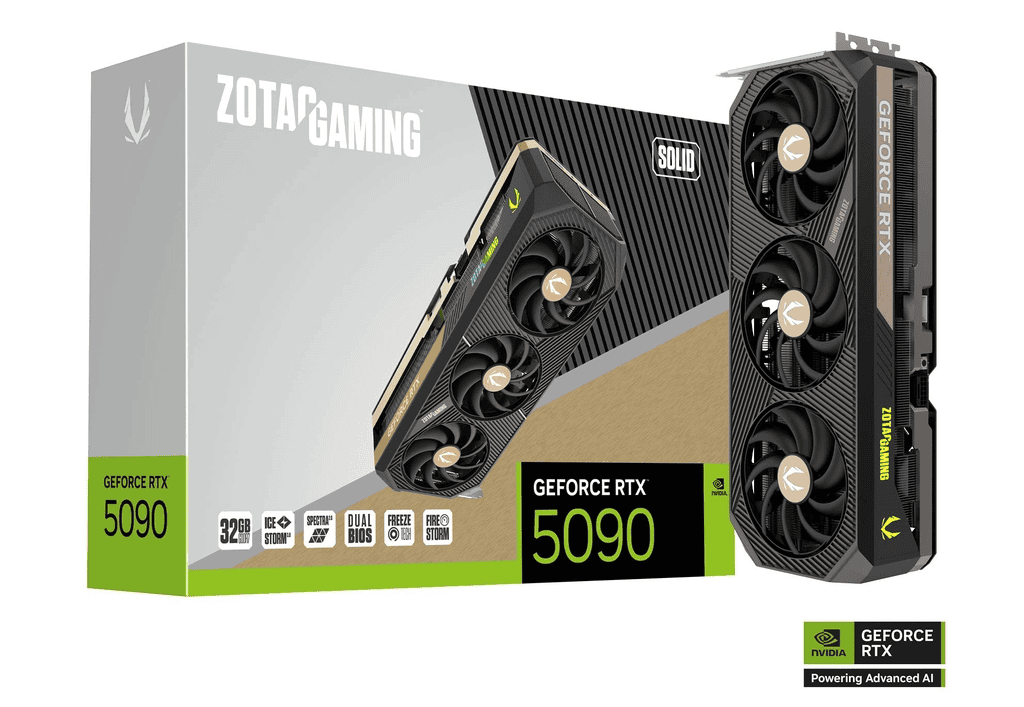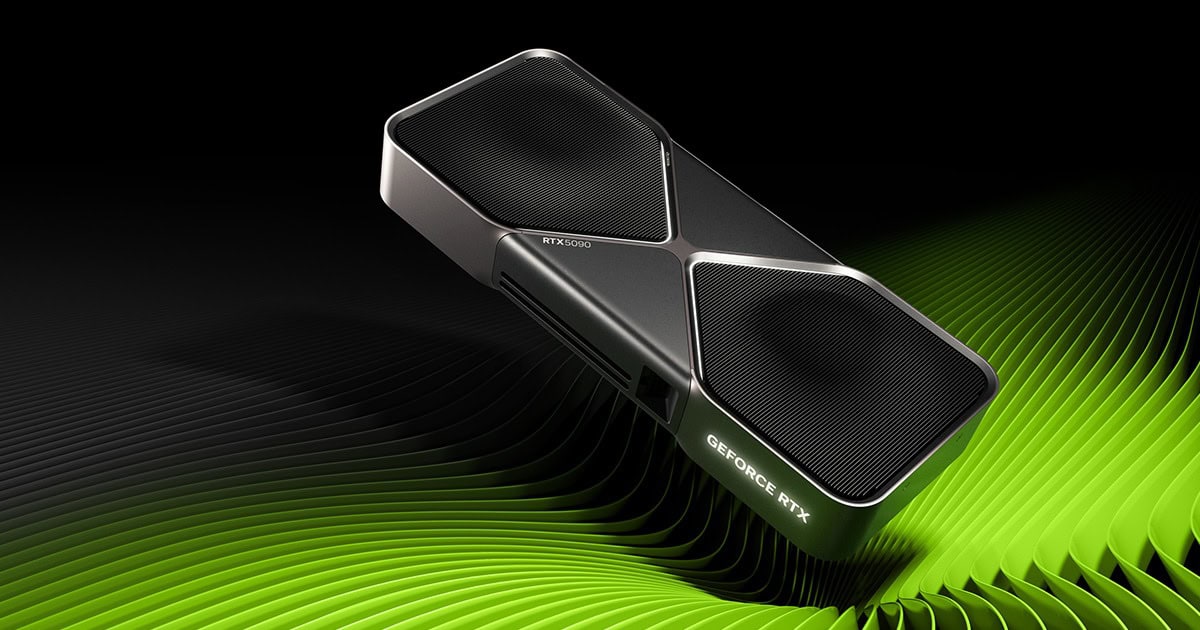The NVIDIA GeForce RTX 5090 is a powerful graphics card that will be available at the end of January 2025. This GPU uses the advanced GB202-400-A1 processor. It contains 92.2 billion transistors and has a size of 744 mm², which means it can deliver an outstanding gaming and creative experience. It supports features like hardware-backed ray tracing and variable-rate shading for new games.
A key feature of this card is its memory. It has 32 GB of GDDR7 memory with a 512-bit memory interface, allowing for fast data processing. The RTX 5090 also includes 170 ray tracing cores and 680 tensor cores, which improve AI performance and machine learning. With a strong cooling system, this dual-slot card is designed to handle demanding tasks while staying stable and reliable.
RTX 5090: A Deep Dive into Performance and Features

Specifications of the RTX 5090
The RTX 5090 is built on Nvidia’s Blackwell architecture. This new design offers a significant leap in performance compared to previous generations. The card boasts 32GB of GDDR7 memory. This fast memory helps with smooth gameplay at high resolutions. The boost clock speed reaches 2.41GHz, allowing for quick processing of graphics. The total board power is 575W, which means it needs a powerful power supply.
| Specification | Value |
|---|---|
| Architecture | Blackwell |
| Memory | 32GB GDDR7 |
| Boost Clock | 2.41GHz |
| Total Board Power | 575W |
| Release Date | January 30, 2025 |
Performance Expectations
The RTX 5090 is designed for top-tier gaming. It aims to deliver smooth frame rates at 4K resolution and beyond. Early tests suggest a large performance increase over the RTX 4090. This makes it a good choice for gamers who want the best possible experience. It is also suitable for professionals who work with demanding graphics applications.
Comparing the RTX 5090 to the RTX 4090
The RTX 5090 brings several upgrades over the RTX 4090. The Blackwell architecture is a major change. It offers improved efficiency and performance. The 5090 also uses faster GDDR7 memory. This provides more bandwidth for graphics processing. The higher boost clock speed also contributes to better performance. The table below shows a comparison of the key specs.
| Feature | RTX 5090 | RTX 4090 |
|---|---|---|
| Architecture | Blackwell | Ada Lovelace |
| Memory | 32GB GDDR7 | 24GB GDDR6X |
| Boost Clock | 2.41GHz | 2.52GHz |
| Total Board Power | 575W | 450W |
Potential Drawbacks
The RTX 5090 has a high total board power of 575W. This means you will need a robust power supply in your computer. The card’s price will likely be high. This may put it out of reach for some buyers. It is also a large card. Make sure your computer case has enough space.
Who is the RTX 5090 For?
The RTX 5090 is for gamers who want the best performance. It is also good for professionals who use demanding graphics applications. This includes video editing, 3D rendering, and AI development. If you want the best of the best, this card is a good choice.
Considerations Before Buying
Before buying the RTX 5090, check your computer’s power supply. Make sure it can handle 575W. Also, measure the space in your computer case. The card is large. You should also think about the price. It will be a premium product. If you do not need the best performance, other cards may be a better value.
Alternatives to the RTX 5090
If the RTX 5090 is too expensive or not available, there are other options. The RTX 4090 is still a powerful card. It offers great performance at a lower price. AMD’s Radeon RX 7900 XTX is another strong competitor. It provides good performance for less money. Consider your budget and needs when choosing a graphics card.
Beyond raw gaming performance, modern graphics cards play a crucial role in other areas. Consider AI tasks. The RTX 5090’s high memory capacity and fast processing speed make it suitable for machine learning and AI development. If you plan to use your graphics card for these types of workloads, the RTX 5090 is a strong contender. For those interested in content creation, the card’s ability to handle high resolution video editing and complex 3D rendering tasks makes it a valuable tool. When making your decision, think about how you plan to use the card beyond gaming.
Key Takeaways
- The RTX 5090 is based on the new GB202 graphics processor.
- Features include 32 GB GDDR7 memory and advanced ray tracing.
- High-performance specifications cater to gaming and creative work.
Graphics Processing Unit
The GeForce RTX 5090 features advanced architectural elements, using the Blackwell 2.0 design. It integrates numerous CUDA cores, optimized streaming multiprocessors, and state-of-the-art fifth-generation tensor cores. Additionally, it includes fourth-generation ray tracing cores, enhancing graphical fidelity and performance. This GPU is built on a 4 nm process with an impressive 92.2 billion transistors, delivering cutting-edge performance for modern gaming and computational tasks.
Video Card
The next-generation GeForce 50 graphics card, with a release planned for January 30, 2025, plans to offer significantly enhanced performance. Designed for PCIe 5.0 x16, it is expected to succeed the GeForce 40. The projected market price is $1,999.
Speed Characteristics
Base Clock: 2017 MHz
Boost Clock: 2407 MHz
Memory Clock: 2209 MHz (effective speed of 28 Gbps)
These towering default clock speeds contribute to high performance, balancing efficiency with a thermal design power geared for demanding tasks.
Memory
The GeForce RTX 5090 graphics card employs 32 GB of GDDR7 memory. This memory is transmitted along a 512-bit bus, facilitating a bandwidth of 1.79 TB/s.
Graphics Processing Configuration
Shading Units: 21,760
Texture Mapping Units (TMUs): 680
Raster Operating Pipelines (ROPs): 192
Streaming Multiprocessors (SM Count): 170
Tensor Cores: 680
Ray Tracing Cores: 170
L1 Cache (per SM): 128 KB
L2 Cache: 88 MB
This setup enhances performance in rendering tasks, providing more efficient graphical processing capabilities.
Estimated Performance Metrics
The GeForce RTX 5090 features remarkable theoretical capabilities. It offers a pixel rate of 462.1 GPixel/s and a texture rate of 1,637 GTexel/s. The floating-point performance varies, with FP16 and FP32 operations reaching 104.8 TFLOPS each. Meanwhile, FP64 operations are recorded at 1.637 TFLOPS. These metrics indicate exceptional AI processing power and efficient handling of complex graphical tasks.
Board Configuration
The GeForce RTX 5090 Founders Edition boasts a dual-slot configuration measuring 304 mm (12 inches) long, 137 mm (5.4 inches) wide, and 48 mm (1.9 inches) in height. It supports a power consumption of up to 575 watts with a suggested PSU of 950 watts. The board includes a 16-pin power connector and offers high-quality HDMI 2.1b and DisplayPort 2.1b outputs, enhancing connectivity.
Visual Capabilities
The GeForce RTX 5090 is designed with advanced features that enhance digital visuals. By utilizing ray tracing technology, it achieves realistic lighting effects. The incorporation of DLSS 4 significantly boosts performance while maintaining high image quality.
For immersive experiences, NVIDIA’s AI-enhanced graphics elevate visual details, providing vivid and true-to-life graphics. The involvement of intelligent voice and video features further improves user interaction.
Furthermore, systems incorporating RTX video super resolution and NVIDIA G-Sync technologies are crafted for smooth, stutter-free visuals, ensuring a superior gaming journey. These attributes collectively push graphical boundaries in modern computing.
Key Aspects of the GB202 GPU
The GB202 GPU is integrated into the RTX 50-series graphics cards, featuring several advanced components. Among these, the 4th Gen Ray Tracing Cores and 5th Gen Tensor Cores stand out. Furthermore, the 9th Gen NVENC and 6th Gen NVDEC capabilities enhance video encoding and decoding, respectively. Additionally, this GPU supports VP13 for PureVideo HD and complies with Feature Set M for VDPAU. It is compatible with the latest driver releases for Windows 10 and 11, ensuring optimal performance across platforms.
Available Graphics Cards for this Architecture (36)
For those interested in high-performance gaming, the NVIDIA RTX 5090 series boasts a range of retail board choices, each offering unique specifications for different needs. ASUS offers the TUF Gaming RTX 5090 and its overclocked counterpart, both designed with a base GPU clock speed of 2017 MHz, a boost clock of 2407 MHz, and memory clock at 2209 MHz. These cards provide a robust triple-slot design, measuring 348 mm, featuring two HDMI ports and three DisplayPorts for versatile connectivity.
ASUS’s ROG Astral series includes both standard and overclocked options. The ROG Astral LC RTX 5090 variants, offering liquid cooling, register the same clock speeds. Their tactile dimensions at 288 mm and support for dual HDMI ensure seamless performance and user experience. Users who prefer conventional cooling will appreciate the larger 358 mm versions, constructed as quad-slot cards for efficient heat dissipation.
In the Gainward lineup, the RTX 5090 Phantom and its overclocked sibling, the Phantom GS, maintain the foundational clock configurations. Users can expect a reliable triple-slot architecture at 332 mm to facilitate high-performance needs.
For those leaning towards specific brand allegiances, GALAX GTX 5090 1-Click OC keeps the consistency in clock speeds while offering a compact 326 mm triple-slot design. Alternatives such as the GIGABYTE series offer an array of options. The AORUS RTX 5090 MASTER, both standard and the enhanced MASTER ICE variant, feature both extensive 360 mm quad-slot designs to maximize airflow. Unique to these iterations, the XTREME WATERFORCE alternatives provide liquid cooling innovation at reduced dimensions, aligning with an 8.2 to 8.7 inches length specification.
For casual to hardcore gamers, MSI’s offerings include the RTX 5090 GAMING TRIO OC and variances in Special Editions supporting both air and liquid cooling technologies. These models span sizes of 280 mm to 359 mm across triple and quad-slot options. MSI’s SUPRIM series provides options like the SUPRIM LIQUID SOC and SUPRIM SOC for those exploring superior cooling and performance avenues.
Venturing into options from PNY, the RGB EPIC-X Overclocked Triple Fan models align their specifications closely, with this series boasting dimensions of 329 mm tailored for intensive applications.
Palit’s GameRock series stands out as well, offering comprehensive options to enthusiasts. Both the GameRock and its overclocked editions, at a size of 332 mm and employing a triple-slot design, affirm the manufacturer’s commitment to performance and style.
Inno3D brings forth models such as the RTX 5090 iCHILL Frostbite and the adaptive iCHILL X3, both maintaining the trademark clock speeds, complemented by meticulous design for optimized heat management.
The KFA2 RTX 5090 1-Click OC ensures a quick access overclocking feature within a practical 326 mm triple-slot dimension to provide users with instant performance enhancement capabilities.
Individuals looking at ZOTAC’s lineup will find the RTX 5090 AMP Extreme INFINITY and SOLID editions maintain the same robust characteristics. Designed as triple-slot cards, dimensions vary slightly with a focus on providing premium performance capabilities at a standard 330 to 332 mm configuration.
When it comes to pricing and availability, factors including design, cooling solution, and brand impact cost variations. Users should review each offering, considering aspects such as connection ports, power requirements, and chassis compatibility before committing.
The RTX 5090 Founders Edition can be anticipated in the $1,999 USD bracket, according to recent announcements, aligning with other high-tier releases. Competitive models like the RTX 5080 and RTX 5070 TI provide alternatives for those considering options fitting different budgets.
Potential buyers may consider their needs relative to performance, design, and sustainable power requirements. Each offering within this architecture offers distinct features and benefits, making careful evaluation crucial to aligning with gaming needs and budget constraints.
Common Queries Regarding the GeForce RTX 5090
Suggested Specifications for Operating a GeForce RTX 5090
The GeForce RTX 5090, with its advanced capabilities, requires a robust system setup to function optimally. Users should ensure a high-performing CPU, ideally a multi-core processor from either AMD or Intel, is part of their setup. The graphics card demands at least 16 GB of RAM to handle intensive tasks. A power supply unit (PSU) with a minimum of 850 watts is recommended to provide stable power, considering its high power consumption.
Performance Comparison: GeForce RTX 5090 vs. Earlier Generations
The GeForce RTX 5090 offers significant improvements over its predecessors. It delivers enhanced computational power, with better support for real-time ray tracing and AI-driven tasks. Compared to previous models, this GPU shows marked enhancements in processing speeds, memory bandwidth, and energy efficiency. Such advancements are particularly evident in gaming and professional applications requiring intensive graphics processing.
Does the GeForce RTX 5090 Facilitate 8K Gaming?
Yes, the GeForce RTX 5090 is capable of supporting 8K gaming. It provides smooth and consistent performance in 8K resolution settings, albeit with some dependency on frame rate optimizations. Users will need a compatible 8K display and might have to adjust in-game settings for a seamless experience, especially in graphics-intensive titles.
Thermal and Power Aspects of GeForce RTX 5090 Upgrades
Upgrading to the GeForce RTX 5090 involves careful consideration of cooling and power supply needs. This high-performance graphics card generates considerable heat, necessitating effective cooling solutions such as high-quality air or liquid cooling systems. Proper ventilation in the PC case further prevents overheating. Pertaining to power, a reliable PSU with significant wattage ensures the card operates correctly under load.
Unique Features and Technologies of the GeForce RTX 5090
The GeForce RTX 5090 introduces several exclusive technologies. This includes advanced processes for AI tasks and enhanced ray tracing capabilities. DLSS (Deep Learning Super Sampling) is improved in this iteration, delivering clearer visuals and smoother frames. Additionally, NVIDIA Reflex technology reduces input lag, benefiting competitive gamers with better responsiveness.
Enhanced Ray Tracing Capabilities of the GeForce RTX 5090
Ray tracing is a cornerstone feature of the RTX series, with the 5090 model displaying remarkable progress in this area. It processes light and shadows more effectively, generating realistic scenes and interactions in supported games and applications. Compared to previous models, it offers faster rendering of complex scenes, fostering superior visual experiences for users.






